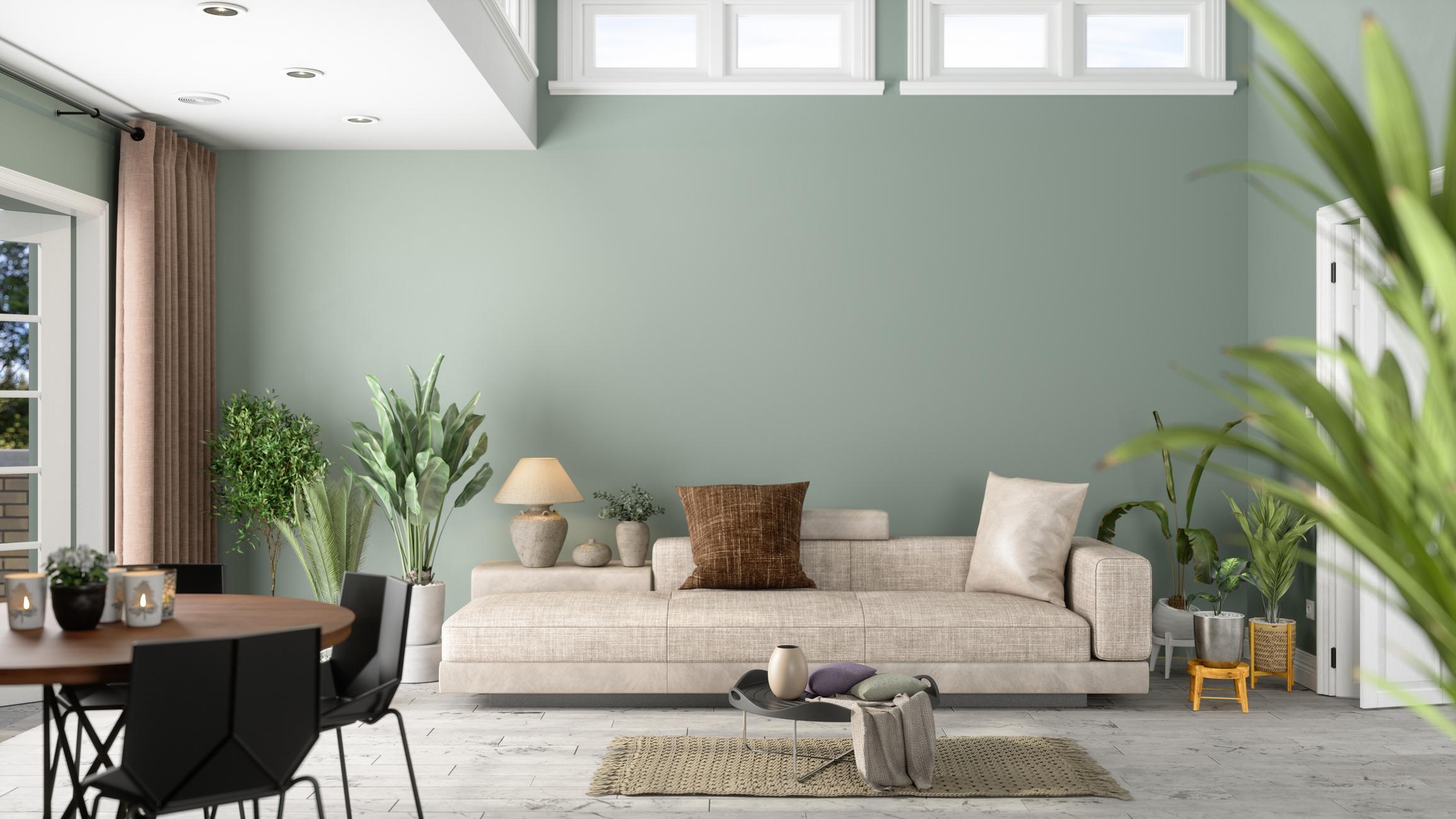Interested in adopting a more sustainable home interior? 7 simple tricks a pro uses
Effortless ways to reduce your carbon footprint (and save £££)...

Effortless ways to reduce your carbon footprint (and save £££)...
Keen to build a more sustainable home interior but not sure where to start?
Sure, you've likely heard of people upcycling furniture and buying secondhand, but how do you swerve brands that are actually greenwashing or not being honest about their own carbon footprint?
Good question. Sustainable home interior is largely defined as homeware and interior design that is kind to the planet and spans companies actively making an effort to cut back on plastic, water, and electrical consumption.
Why's it so important? Because we're facing the worst climate crisis to date. The fact that nearly a third of UK adults throw away furniture and homewares that are in great condition that could be reused or resold isn't helping. "Many now approach their homeware like their fashion choices - impulsive, seasonal and trend-led - creating a throwaway culture," shares sustainable interiors expert and founder of Narchie - coined "Depop for homeware" - Harriet Wetton.
Each year, approximately 1.6 million tonnes of bulky waste is incinerated or sent to landfill in the UK alone, and about 42% of this is furniture - 670,000 tonnes. "That’s the equivalent of 30 Statues of Liberty, 65 Eiffel Towers, or about 6,500 blue whales," shares the expert.
To help you spot the eco-friendly from the not-so-much and create your own sustainable home living space, we've enlisted the help of Wetton. Keep scrolling.
Sustainable home interior: your guide
Did you know? While the homeware and furniture industry is often overlooked, it in fact creates a huge amount of waste, shares Wetton.
Celebrity news, beauty, fashion advice, and fascinating features, delivered straight to your inbox!
So what does building a sustainable home interior actually entail? To the app founder, it stems down to making conscious decisions when decorating your home. "Whether that’s supporting independent brands, upcycling furniture to give them a new lease of life, buying pre-loved or antique items, or generally choosing an alternative to mass produced "throw away" items, it all counts," she shares.
Why is opting for a more sustainable way of living so important? As above, because we're facing a climate emergency, and every little helps. "Buying second-hand and vintage is giving new life to something that would otherwise be chucked away, which are often items that still have plenty of life left in them," shares Wetton.
What are the benefits of adopting a more eco-friendly approach to interior design?
There are plenty. Not only will you be doing your bit for the planet, but you'll be saving your pennies, too. Secondhand furniture sites like Gumtree, Facebook Marketplace, Ebay, Narchie and so on often offer some real steals, if you look hard enough.
That, and you often get better quality for your money with vintage and secondhand items, shares the expert. "We’ve noticed that mid-century and iconic furniture is currently really popular on the app, alongside unique second-hand glassware, which is a lot more affordable than buying brand new," she goes on.
Not to mention the fact decorating with vintage and second-hand pieces is an easy hack for creating a more unique interiors aesthetic.
"You usually find pieces that have a great story or history," Wetton adds. "It’s really rewarding when your rooms are made up of pieces you genuinely love, and won’t find in other people's homes. It gives your home the opportunity to really reflect your personal style."
Nervous about buying pre-loved items and mixing and matching the old with the new? Wetton's advice is don't be. "As long as you love it and your curation of items have elements which are special to you, it will work," she reassures. "Don’t be frightened to go with what you love."
6 top tips for adopting a sustainable home interior
Ready to give it a go? Let Wetton's top tips guide you.
1. Shop second-hand
First things first - rather than going to, say, John Lewis, Made, or Ikea as your first port of call, try and source homeware and furniture from second-hand and independent sellers.
You could try sites where people list their own items, like Facebook Marketplace, Gumtree, Depop, and Ebay, or apps that curate independent brands, artists, and makers, like Narchie.
2. Support small
Next stop: make sure to buy from independent brands who make to order or do small batch production runs where you can, recommends Wetton.
"This massively helps to reduce the number of mass-produced items going to waste, and also allows you to support local independent creatives and artisans," she shares.
3. Do your research
And educate yourself on the brands you're spending your money with. Checking out if they are a verified B Corp brand is a simple way to check that they actually have eco-creds (it takes years to qualify for the certification).
"My advice is to work with tradesmen and businesses who use reclaimed materials - The Main Company are a great example of this," shares Wetton. "Their experts salvage the best raw, rustic materials that they can use to create cladding, flooring, and bespoke kitchens, giving reclaimed materials a new lease of life."
4. Make small swaps
Thinking of actually renovating your home to make it more sustainable? There are sustainable options for everything these days, from paint rollers, to wallpaper, to paint itself.
"Where possible, invest in quality brands like COAT paint, who are one of the only carbon-neutral paint companies in the UK," shares Wetton."After all, being sustainable at home is all about making swaps where you can and choose to work with brands who are striving to make a change, too."
5. Invest where you can
Another way to make sure you don't start racking up carbon emissions for the sake of a mood-boosting living room?
"Buy pieces that you love and will want to keep, rather than being swept up in trends that you may not want in a few month's time, as well as opting for well-made second-hand and vintage items that have already had a life, and can be passed on again and again," advises the expert.
6. Re-use and restyle
Reusing and restyling things you already own is one of the easiest ways to give your living space a refresh without spending much money at all (or creating waste, in the process).
Wetton's top ideas include:
- Upcycle furniture
- Reframe artwork
- Swap draw handles
- Dye cushion covers
- Paint cupboards
- Move decorative items
- Swap curtains.
"These are just a few examples of how you can give your homewares a glow-up without buying new," she shares.
7. Pass it on
And finally, if you find yourself hanging on to things you no longer need, remember that there's a loving home for them elsewhere. "Do sell things you no longer love or have room for rather than sending to landfill," recommends Wetton. That, or donate them to charity.
Remember, one man's trash is another man's treasure, she shares.

Ally is Marie Claire UK's Senior Health and Sustainability Editor, a well-regarded wellness expert, ten-time marathoner, and Boston Qualifying runner.
Utilising her impressive skillset and exceptional quality of writing, she pens investigative, review and first-person pieces that consistently demonstrate flair and originality.
As well as writing, Ally manages a team of freelancers, oversees all commissioning and strategy for her pillars, and spearheads the brand's annual Women in Sport covers, interviewing and shooting the likes of Mary Earps, Millie Bright, and Ilona Maher. Shortlisted for three BSMEs and winning one in 2022, Ally lives and breathes her verticals: her eye for a story and connections within the wellness sphere are unrivalled. Follow Ally on Instagram for more.
